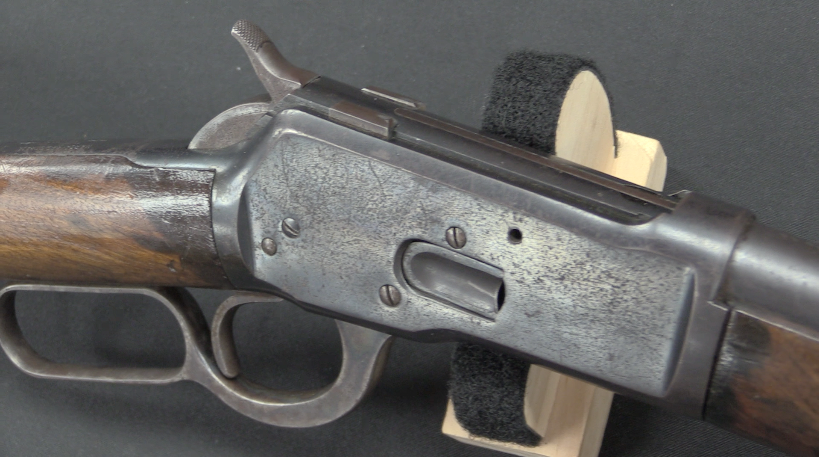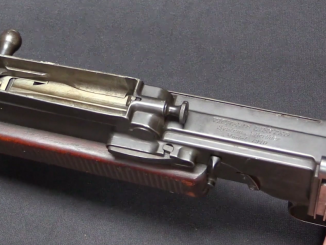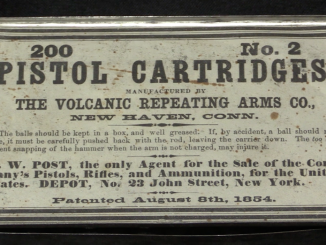This is Lot #1236 in the upcoming December 2020 RIA Premier auction.
At the suggestion of Colonel J.C. Kelton (Assistant Adjutant-General, Military Division of the Pacific and Department of California), the US Army adopted a 20ga shotgun version of the Trapdoor Springfield in 1881. Built at a truly minimal cost using 1873 actions and condemned .58 caliber barrels bored out to .635 inch (20 gauge), these Model 1881 shotguns had only three new parts (extractor, front sight bead, and screw lug attached to the barrel).
A total of 1,376 were made by 1884, and two were issued to each infantry company stationed west of the Mississippi. The purpose was to give soldiers some recreation and also a way to add some fresh game to the rather stagnant rations of barracks life in the post-Civil-War western Army. They were very well liked, and remained in posts until at least 1900.




Stagnant and tasteless food can cause soldiers to perform rather miserably in the field. I don’t want to mention the hardtack crackers so hard that they were considered weapons themselves. I could be wrong.
No, you’re not. Hardtack was both easily made by factory methods, easily transportable, stable in storage, and even fairly nutritious. That didn’t mean it was particularly palatable.
As Jack Coggins relates in Arms and Equipment of the Civil War, hardtack was often moldy, infested with “worms” (weevil larvae), or both. A common joke(?) among the troops was that “all the fresh meat came in the hardtack”.
A common solution was to dunk the “cracker” in hot coffee. The “worms” would try to get out, drown, and float to the surface where they could be skimmed off and dumped. It didn’t affect the flavor of the coffee, and the combination of softening and coffee flavoring made the hardtack a bit easier to swallow and digest.
Yes, dunking donuts in coffee is a throwback to this Civil War “field expedient”.
Considering the provisioning problems the armies on both sides experienced from 1861 to 1865, providing the troops on the western frontier after the war with a foraging shotgun made perfect sense.
According to an article in the 1982 Gun Digest, “Firearms in Apache Tribal Use” by D. C. Cole, standard Trapdoor Springfields in .45-70 were commonly used as “field expedient” shotguns on the reservation when he was a boy in the late 1940s and early 1950s. Their rifling was worn out smooth, but they worked very efficiently as cylinder-bore shotguns when loaded with .410 ammunition. .45-70 cases reloaded with shot loads, essentially brass-cased shotgun rounds, were also used.
The Allin conversion may have been a better “foraging” shotgun than it was a combat rifle.
cheers
eon
The “solution” of using liquid to soften hardtack was not new and was actually extremely old by the 1860s. The idea of hardtack actually goes back to Rome (as buccellatum) and was in common use by sailors for centuries prior to the Star of the West incident, and both softened it in soup.
Collecting game to supplement rations in Czechoslovakia after the war led to some enterprising tankers driving around in a jeep w/ a passenger-side mounted M1919, hunting the little European roe deer. I asked if it tore up the meat – the old Aggie responded, surprised,”You just shot em til they fell down!”
My uncle was in a South Dakota NG outfit at the beginning of WWII. They were training in California getting ready to go overseas. The people in SD went hunting and collected enough pheasants to feed a company of hungry artillery men. The birds were shipped in dry ice and the medical officer condemned them since they were shot with lead pellets and everyone knows lead is poisonous! Times had changed even back then.
Times never change.
But there are always smart and quick-witted people.
He just sold these pheasants to a restaurant. 😉
Sounds pretty cool of the US Army…issuing recreational guns!
I wonder if the french or prussians issued shotguns built on the dreyse or gras actions. Lots of shotguns were built on these actions for civilians before 1900 but I dont know if any were actually issued to the troop
From the sources I read so far, I don’t see reference about French military distributing converted Gras shotgun.
If I understand well, a part of the stock was sold to private armorer when the Lebel was available in sufficient quantities. During WW1, a part of the remaining stock was converted to 8mm Lebel M14 and a second batch of remaining Gras was converted into shotguns afterwar and sold to civilians by the MAS.
Sources :
http://fr.1001mags.com/parution/gazette-des-armes/numero-463-avril-2014/page-32-33-texte-integral
http://armesfrancaises.free.fr/fusils%20de%20chasse.html
I had a great aunt who found a trapdoor Springfield in an abandoned cabin in Mason County, Texas when she was very young. She used to load .410 short shotshells and kill turkeys with it.
Russians converted so many Berdans to shotguns (and then sold them to civilians) that the word “berdanka” is a colloquial term for any civilian long arm whatsoever, or at least it was so in the 50s-70s.
Was intended as a reply to BOBTAIL101
“Russians(…)”
There is also name Фроловка applied to Mosin rifle converted to shotguns.
https://ru.wikipedia.org/wiki/%D0%A4%D1%80%D0%BE%D0%BB%D0%BE%D0%B2%D0%BA%D0%B0_(%D1%80%D1%83%D0%B6%D1%8C%D1%91)
Yes gras shotguns in 13 20 and 28 gauge are the best value in french antique cartrige arms
I bought my first one for 10 francs minus the stock. My best one was only 50 euroes with the stock in 16 gauge
Unbarreled gras /chaussepot receivers without the bolt go for about 15 euroes but used to be 5 francs ie 1 euro is about 6.559 francs
T have seen 12 gauge conversions of the 1888 commission rifle and ww1 mauser 98’s but they cost about 150 euroes T think a berden conversion would be great as it would be in D2 a pre 1900 antique and free for sale to anyone over 18 as are the gras but not the mauser 98’s
I have a WW1 Mauser 98 that was converted to 16 ga by Geha.
Keeping French troops happy on salt beef and hardtack? In garrison? I much doubt it. But letting them hunt over some nobleman’s property? Jamais! The American armies in the West were in a novel position: poor rations but nobody to object to soldiers hunting on public lands. I wonder how army cooks served up those delectable birds and rabbits?
Regarding that trapdoor shotgun: Springfield should have left the cleaning rods in place. There were bound to be stuck empties from time to time, the Allin conversion being what it was, and they’d need poking out.
I have heard of many people using .410 shotgun shells in 45-70 Trapdoor rifles. I have also seen a military style shot shell loaded into a 45-70 case with a wooden capsule for the shot over a black powder charge.
HI Ian . Great stuff The british had a similar single barrel shotgun modelled on the standard Enfield percussion musket .. I have two . I initially thought they were bored out surplus sold to the public! NO they were for soldiers recreation! One of mine is of Belgin make with what appears to be standard lockwork etc. The Brits sold off Mark 111 >303s in the 1950s as a wait for …it “Garden Gun” bored out to.410 !!!! this was to get around their increasingly harsh gun legislation….shot guns were still permitted to keep Peter Rabbit out of the garden! The magazine did not handle them too good till it was modified back to single column …. Lee Speed ghost returned! lets not think too hard on a .410 slug! Have also a French military bolt action bored out to 12 Ga they were it seems a commonly done use of surplus guns…. Its a deathtrap …on OPENING the loaded breech …. IT FIRES!!! Remember all french things are male or female gender of this shocker has me confused Cheers Rich love your info
Friends,
Does the Type 99 Arisaka rifle conversion to .410 count?
Best,
Q
The existence of a “hunting team” was spelled out in the charters of many armies. Some used .22LR training rifles for this. Others produced “hunting” cartridges for service rifles. And some produced shotguns converted from old rifles. For a long time the British used the “colonial” Martini-Henri for this.
The rest used what was available.
For example, Russians in Eastern Europe shot roe deer from service machine guns while driving around at night in armored personnel carriers.
During WW2, most of the hunting rifles in the USSR were collected from their owners, ostensibly on nails for tanks. In fact (as usual in Russia) the most valuable were immediately stolen by the police. And the rest rusted in the basements until the end of the war, when the surviving owners were able to take what was left. If they’re lucky.
It was not only the old Mosin and Berdans that were being altered. Various trophy weapons were altered, primarily using scarce cartridges. Mannlicher and stuff.
I’ve posted this before but. In the summer of 1946 my dad who had been asub. lieut. in the canadian navy 1944/45 was asked if he wanted to go out to camp shilo manitoba during the summer(and be paid) Apparently during the war there had been a lack of coordination between army and navy artillery.
At any rate when he got out there the place was overrun with deer as nobody was shooting much during the war as they lacked ammunition. As there was some decent lee enfields on the base and ammo was free a few of the boys started poaching deer and selling the meat to local restarants. Ufortunatly this came to an end when the head of the camp decided to go deer hunting in a bren gun carrier using a brengun and the local mounties got to hear about it
The Bren is a very accurate gun, and would make a decent hunting rifle if used in semi-auto. But if this fellow used it on full auto he was clearly no sportsman.
ate gun .my brother in law saw a lot of serious stuff retreating from greece & crete the NZs took out stupas wholesale , …Stukas arriving ..run away from trucks… find a hole for cover!… load up mags(1 AP @ Tracer …have spare mate as loader (mags already….. Open up from the hip as soon as you can see the crew in the 9’glasshouse” …takes half a mag to zero in ….mate fits spare mag…… BOMB leaves Stuka …SHOUT ONE & Dive for cover in hole…. the bomb will go off (hit the ground at the count of 3 or 4!!!! you got to be in cover!& STAY THERE….Stuka dive control takes over as bomb leaves…. stukaclimbs… if violet is still alive he takes over (with a damaged craft ….OR if he is dead/injured the plane keeps climbing …Turns on its back ….& COMES RIGHT BACK >so ..STAY IN YER HOLE!!! Jock said the old hands got very good…he claimed 5 destroyed!…… I saw a trophy Luger holster with the tell-tale 3 holes close together @ 1.5 inch group! the owner said oh a bren got him the pistol was out in his hand! accurate alright! …did not climb on full auto the experienced guys tried not to fire too much as it gave their position away & they tried to do the job with minimum ammo! How Lucky We Are.
IIRC, officers were allowed to privately purchase these foraging pieces